The deck is the most important part of the house, and it needs to be taken care of very well. Because it is constantly exposed to the elements. These elements include the sun, rain, snow, and ice. These can all harm the deck if it is not properly cared for.
Deck staining is an important part of maintaining your deck and keeping it looking its best. A semi-transparent stain is a great option for those who want to protect their deck while still allowing the wood grain to show through. But how many coats of semi-transparent stain should you apply to your deck?
If you’re wondering how many layers of semi-transparent stain should be applied to your deck and where they’ll go, this article is for you. We guide you with the number of coats so that your deck looks fabulous.
Let’s get started!
What is a Semi Transparent Stain and How Does it Work on Deck?
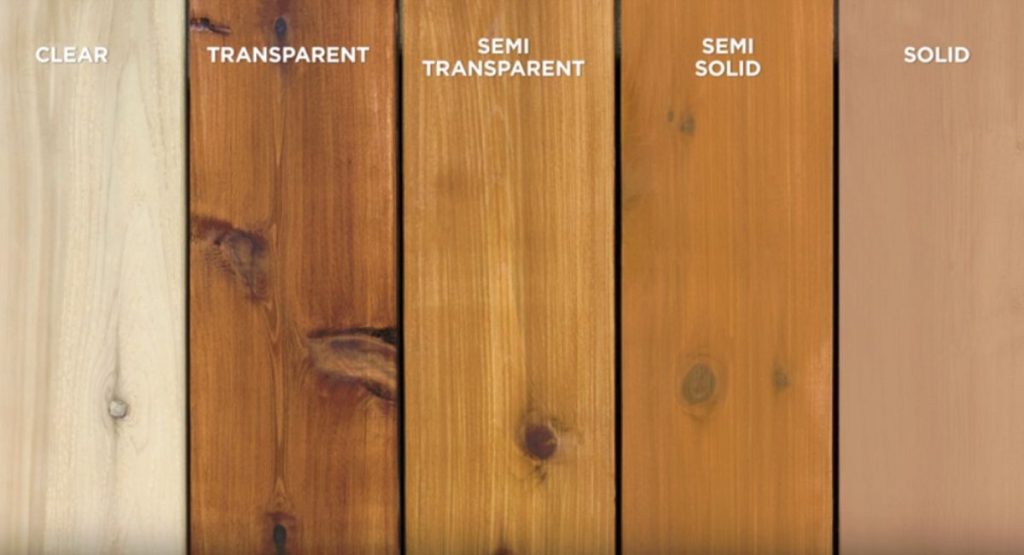
The word semi means that it is not completely solid like paint, but it is also not completely transparent like a sealer. This allows for a bit of both worlds when it comes to protection and beauty.
Semi Transparent stain is a type of stain that is usually made up of a dye, pigment, and binder.
- The binder is what helps the stain to adhere to the surface of the wood.
- The pigment is what gives color to the stain. Pigment stains are made up of finely ground particles of color suspended in a binder. These stains provide good coverage and UV protection.
- Dye stains are typically made up of a single colorant dissolved in a solvent. This makes them very concentrated and can penetrate deep into the wood grain.
If you apply a semi-transparent stain to your deck for the first time, then you should know the number of coats to apply, as this will ensure that your deck is properly protected.
How Many Coats of Semi Transparent Stain were Applied to the Deck?
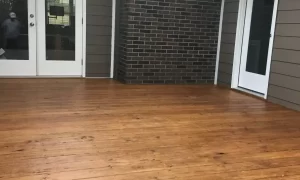
The number of coats of semi-transparent stain that you should apply to your deck depends on a few factors, which are listed below:
Type of wood that your deck is made of:
If your deck is made of softwood like cedar or pine, you must apply more than one coat of stain to provide adequate protection. These woods are more prone to damage from the elements and need to be protected more.
Softwood actually refers to the fact that the wood has a lower density than hardwoods. This means that it is more porous and will absorb stains more readily. so you will need to apply more coats of semi-transparent stain to provide adequate protection.
If your deck is made of hardwood like mahogany or ipe, you can get away with applying one coat of semi-transparent stain. These woods are denser and will not absorb the stain as readily. This means that you won’t need to apply as many coats to get adequate protection.
The amount of sunlight that your deck gets:
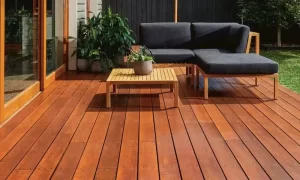
Sunlight can be a tough enemy for any deck. It can cause the deck’s wood to fade and crack over time. The cracks on the deck are usually filled with dirt and mildew, which can be difficult to clean.
If your deck gets a lot of sunlight, you must apply more coats of semi-transparent stain. Because the more sunlight that hits the deck, the more protection it will need. These more coats of stain help the deck to prevent the sun from damaging the wood.
When your deck is in a shadier location, you’ll need to apply just a few coats of semi-transparent stain.. because in shady areas, wood is not getting direct sunlight, and it’s not as likely to fade or crack.
The climate that you live in:
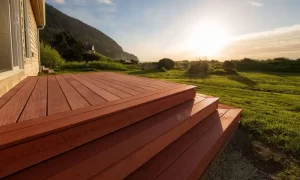
If you live in an area with a lot of rainfall, you must apply even more coats to your deck. This is because the rain can wash away the stain and leave your deck unprotected. So you must ensure your deck is prepared for heavy rainfall. Otherwise, your deck will be unprotected, and it can get damaged easily.
If you live in an area with very little rainfall, you can get away with applying single coats of semi-transparent stain. Because the rain is not as likely to wash away the stain, and your deck will not be exposed to the elements as much.
The amount of traffic that your deck sees:
Traffic on your deck can wear down the finish of the stain and leave the wood unprotected. In this case, your deck needs more protection, and you should apply additional coats of semi-transparent stain.
When your deck sees very little traffic, you can get away with applying one coat of semi-transparent stain. Because the finish will not be worn down as quickly, and your deck will not need additional coatings.
If you have a lot of traffic on your deck, you must apply more than one coat of semi-transparent stain. Usually, two coats are sufficient for high-traffic areas. This will help to protect your deck from the wear and tear of foot traffic.
The type of semi-transparent stain that you use:
When you are choosing a semi-transparent stain, you need to consider the type of protection that it will provide. Some stains are better at providing UV protection than others.
If you want a stain that will provide good UV protection, you should choose a semi-transparent stain with a high percentage of pigment. This stain will provide a barrier against the sun’s rays and help prevent your deck from fading. So this stain applies to two coats or more.
If you are not concerned about UV protection, you can choose a semi-transparent stain with a lower percentage of pigment. This stain will not provide as much protection against the sun, so this stain applies to one coat.
What are some Tips for Staining a Deck?
There are some things that you should keep in mind when you are staining your deck. These tips will help you to get the best results possible.
1. Make sure that your deck is clean before you start:
When you stain your deck, you need to ensure it is clean. This means that you need to remove all of the dirt, debris, and leaves from the deck’s surface. You can do this by power washing the deck or using a stiff brush to scrub the surface.
2. Apply the first coat of stain with a brush or roller:
Once you clean the surface of your deck, you are ready to apply the stain. You can do this with a brush or roller. Both of these methods will work.
Apply the first coat of stain evenly across the surface of the deck. Make sure that you do not miss any spots. Otherwise, the stain will not be evenly applied, and it will not look as good.
3. Allow the first coat of stain to dry completely before applying the second coat:
After you apply the first coat of stain, you need to allow it to dry completely before you apply the second coat. Otherwise, the second coat will not adhere properly and cause the stain to peel.
Apply the second coat of stain in the opposite direction of the first coat:
When you apply the second coat of stain, you need to do it in the opposite direction of the first coat. The reason for this is the stain will not pool in any one area. And all areas of the deck will be evenly coated.
4. Allow the stain to dry completely before walking on the deck;
Once you have applied the stain, you need to allow it to dry completely before you walk on the deck. otherwise, you will leave footprints in the wet stain. The footprint will be difficult to remove, and they will mark the deck’s finish.
5. Enjoy your newly stained deck:
If you’ve just finished staining your deck, congratulations! You’ve taken an important step in preserving your outdoor space. Now it’s time to enjoy all that your newly stained deck has to offer. Here are a few ideas to get you started:
Host a barbecue:
What better way to show off your new deck than hosting a summer cookout? Invite your friends and family for some burgers and hot dogs fresh off the grill. Don’t forget the s’mores for dessert!
Have a picnic:
If cooking outdoors isn’t your thing, try having a picnic instead. Spread out a blanket and enjoy a leisurely meal in the sun. Be sure to take in the beautiful view from your new deck.
Relax and unwind:
After a long day, there’s nothing better than kicking back on your deck with a good book or a cold drink. Enjoy the peace and quiet of your own backyard oasis.
No matter how you choose to enjoy it, make sure you take some time to appreciate your newly stained deck!
Frequently Asked Questions:
Q.What is the best time of year to stain my deck?
A. The best time to stain your deck is in the spring or fall. The weather should be mild and there shouldn’t be any rain in the forecast. This will give the stain plenty of time to dry and won’t put unnecessary stress on the wood.
Q.Can I stain my deck myself?
A.Yes, you can stain your deck yourself. However, it is important to follow the directions on the stain carefully and to make sure that you apply it evenly. If you’re not sure how to do this, it’s always best to hire a professional.
Q.What happens if I don’t stain my deck?
A.If you don’t stain your deck, the deck will start to deteriorate. It will become dry and cracked, and it will eventually start to rot. This can cause serious damage to your deck and make it unsafe to use.
Q. Do I need to remove the old stain before I apply a new one?
A. In most cases, you will not need to remove the old stain before you apply a new one. However, if the old stain is peeling or flaking, it’s best to remove it before you apply the new one. This will help to ensure that the new stain adheres properly.
Conclusion:
Applying a semi-transparent stain to a deck can be tricky. When do you stop? How many coats should be applied? What type of finish is desired? These questions need to be answered before starting the staining process. In this post, we provide tips for staining a deck along with an answer to the question, “how many coats of semi transparent stain were applied to the deck?” We hope these tips help you achieve the perfect finish on your next project! Be sure to visit our blog regularly for more helpful advice and information.

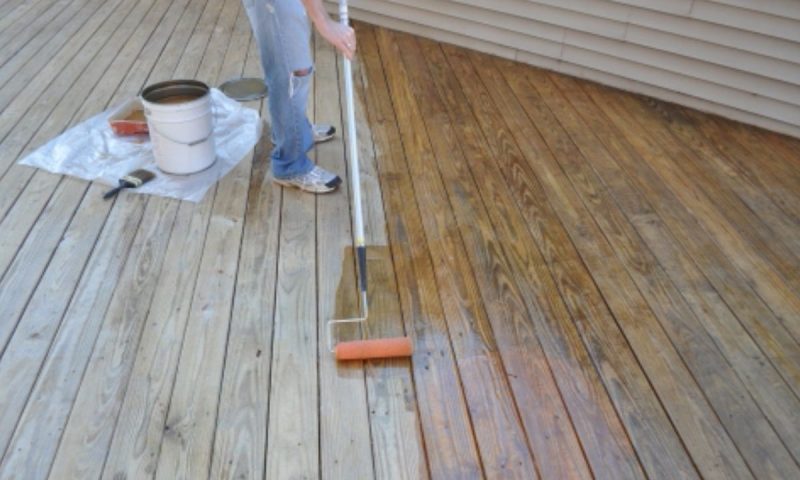
17 thoughts on “How Many Coats Of Semi Transparent Stain On Deck?”
Comments are closed.